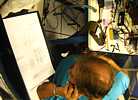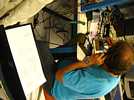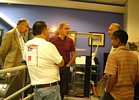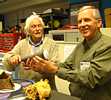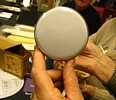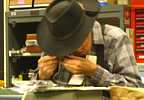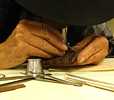Schedule October 2009
return to main 1401 Restoration Page
go to Team Bios
Contents:
Wed October 07 - general
Stan and Ed came in before 9:00 to run the systems so that a NPR (National Public Radio) crew could record the sounds of the various parts of our IBM 1401 systems. Included were, fan noises of the 1401 processor, 1402 Card Reader/Punch reading, the 1403 printer doing BIG PRINT and also Powers of 2, the 729 tape drives loading and unloading, and also the machine gun chatter of their start/stop operation. As an encore, Stan performed on one of our four IBM 026 key punches ;-))
- Attendees: Ron Williams, Bob Erickson, Frank King, Allen Palmer, Bill Flora, Glen Lea, Joe Preston, George Ahearn, Stan Paddock, Jim Hunt, Judith Haemmerle, Ed Thelen, Robert Garner
- Judith Haemmerle is back from her sebatical at the Ford Auto Museum. Judith says that they really collect anything, including steam engines with flywheels 26 feet in diameter. Also there is most of Edison's lab, transported from Menlo Park.
- Bob Erickson worked on the 513 Reproducing Punch - verifying that the pump self primes (after the insertion of Stan's 0.004 teflon (shim) material in the back of the pump). (This old automobile trick is probably not up to IBM or museum standards, but it seems to work and saves a difficult re-manufacture of the pump. Here are two 25 second .wmv movies of 4.5 megabytes each.
- - Bob checking the oil flow
- - Input Hopper and Punch Bail in action
- Joe Preston was operating between tape drives, I couldn't get a proper picture of him working
But I did catch Jim Hunt. He checked all spare ADB cards and is starting to fix the low priority SMS cards now. Here he is multitasking, talking with wife and:
Checking schematic
Testing a card- Dick Oswald, Joe Feng and John Best of the RAMAC crew were getting unexpected torque results from their magnetic clutches (almost identical except coil wire with the transistor driven 729 clutches).
Here they are talking with Allen Palmer, who with Grant Saviers, had rebuilt the German 729 clutches. Allen had the drawings of the clutches so the RAMAC crew could study the magnetic path. Here are measured torque vs current curves. 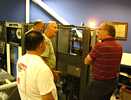
Allen's friend showed up.- Ed Thelen is on a campaign to understand how the 1403 print hammers are timed with the horizontal movement of the print chain. Ed can explain how a drum type printer works with a special off line core memory in about 15 minutes.
- However, not only is the horizontal movement a more interesting problem, to save cost, the 1401 system did not use a separate core buffer (in the basic machine) which made the repeated scanning memory "interesting".
- Here is a 5 megabyte copy of "IBM 1401 Data Processing System Instruction Logic" R25-1496. Ron Williams points out that an explanation starts on page 88 and continues through 94. Ed noted that it was at such a high level that the sync and timing pulses from the 1403 are not even mentioned :-((
- To better understand the operation, Ed used Ron's 1/10 th inch scale to compare chain character spacing with the print hammer spacing. (This is the 'A' type chain, very common in business applications.)
- Here are 6 sequential pictures of the chain, each about 20 KBytes 1, 2, 3, 4, 5, 6
and a combined image if your browser permits you select "actual view".- Stan was showing folks enhancements to the user interface to ROPE.
Thursday October 08 - Tape Team
1401 Debug Status - Oct. 8, 2009 - (Sam S., Jeff S., and me)
We created two more diagnostic tapes today. We now have tapes in the Emulator library for:
(See log for more details.)
- CPU diagnostics - DiagCPU.tobj
- Printer/Punch diagnostics - DiagPP.tobj
- Tape diagnostics - DiagTapeLite.tobj
The CT CPU is now turning the Process Check light on during the Edit diagnostic. It used to work.
We have 1402 Reader diagnostics, but it doesn't make sense to run them from tape. (Input is redirected from the Reader to the Tape.) If desired, we can punch them to cards for the 1402 team to run. (assuming the punch works)
We ran the Printer/Punch diagnostics. The Printer diagnostics ran to completion and the output looked OK (we didn't closely examine; it's still on the printer output tray). The Punch diagnostics ran to completion, but we had to hold the START button down on the 1402. I don't know if the cards punched are correct.
The Tape diagnostic tape was also tested. The 5000-Card-to-Tape diagnostic seems to be broken when run from tape. We don't have a valid source listing and the CPU branches to locations far outside the program. The "Lite" version of the tape eliminates this test. It seems to run OK. (Note that the VRC (5080) diagnostic will print error messages when expects odd parity. The Emulator defaults to generating even parity for all transfers. Having it observe written parity requires the altering of a flag.)
To get all of this to work we had to reattach the Emulator to the tape channel and reconnect power. Someone had removed the power strip it was plugged into.
No problems were detected in the TAU.
Regards,
Bob Feretich
Saturday October 10 - 2nd Saturday
Wednesday October 14 - General
- Attendees: Ron Williams, Bob Erickson, Bill Flora, Glenn Lea, Joe Preston, Stan Paddock, Bill Newman, Jim Hunt, Ron Crane, Ed Thelen, Robert Garner
- The CT 1401 would not read cards for the first 20 minutes after power up. This is not the first time :-(( Bill Flora says that just about the time he is getting to the defective area, the machine starts to work properly.
- This used to be called "Morning Sickness". Probably we should lower the set point on the air conditioning machine ( to keep the room cooler say 10 degrees ) and see if that helps extend the problem for complete trouble shooting.
- from Stan Paddock - re: Question: How many equivalent punched cards did a 2400-ft reel hold?
I ran a short program to try and figure this out.
- I tried to find the longest tape in our storage. (biggest diameter)
- I loaded the tape on drive one of the CT machine.
- My program wrote 1600 character (blocking factor 20 for cards) records at 556 BPI. 3/4 inch assumed for inter-record-gap.
- After each write, I checked for End-Of-Reel
- If not, I added one to a counter and went back to write.
- When End-Of-Reel was detected, I printed out the total number of records written.
According to Ron Williams, most customers used 556 BPI because 800 BPI was not that reliable on the 1401.
. 556 BPI Extrapolating to 800 BPI Records 7,591 10,014 80 character cards 151,820 200,280 characters 12,145,600 16,022,400 feet of tape used for data 2,295 2,295 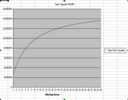
Bob Erickson decided to make all 16 of the 077 collator compare positions work. Previously only 12 worked, the rest had open coils. The third hand in the pictue is Glenn Lea's, who was acting as surgical nurse. 

That "G. Gordon LIddy Tool Kit" is some of Ron Williams' high jinks. - At the far right, Bob is cranking the machine until a contact near his left wrist "makes" and lights a test light to the far left.
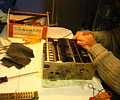
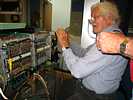
Recent Shipments received - Buzz Bellefleur found some more SMS cards, squirreled away some where.
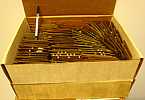
Tape that had been shipped from CT to Paul Pierce for reading - 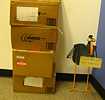
And some circuits excitements - Jim Hunt was trying to fix an oscillator card. The replacement transistors - IBM 065 - were not working consistently. and the 065 transistors were not listed in cross reference, and we had no more of them. A similar device (2N1306) sells for about $10 from all sources we could find. - Somehow Ron Crane (left) appeared to try to work out the problem.
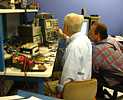
Kirsten Tashev of the museum staff mentioned that she would like to put the 83 character Museum mission statement "preserve and present for posterity the artifacts and stories of the information age." somehow onto an 80 column card - Jim Hunt, who has teen kids, offered the top "text message" ;-)) - It turns out our key punches have different character sets, one gives +, another &

Joe Preston has been working all day on the CT tapes. I think he is taking a break, but that doesn't look like PlayBoy that he is studying so intently - 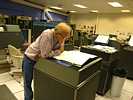
Thursday October 15 - Tape Team
Wednesday October 21 - General
- Much of the following is from Ron Williams.
- Attendees: Ron Williams, Bob Erickson, Bill Flora, Joe Preston, George Ahearn, Stan Paddock, Bill Newman, Jim Hunt, Ron Crane, Judith Haemmerle, Robert Garner
- There was a BIG (like 18 people) conference call of 1401 old timers - people who had designed, produced, marketed, managed, ... the 1401 in the late 1950s. Robert Garner had started looking for the original team about a year ago - Of course luck helps - he found that Fran Underwood (1401 archetect) had lived in the early 1960 not far from where Robert lives now - Bill Flora of the 1401 restoration team is a neighbor of George Ahearn, goes to the same church, but somehow the 1401 never came up - and many other surprises.
- There is a presentation by some of the original group November 10th, and about 10 others will also be present.
- Ed Thelen was at Grant Saviers' workshop with Dave Bennnett and John Best of the RAMAC restoration group. They were concerned about several things about the RAMAC magnetic clutches
- a) a noisy bearing
- b) apparently weak and unequal (20% difference) forces from the two clutches
See RAMAC, Oct 21, 2009- In the morning, some outside movie orginization were photographing - they caused little disturbance.
- The CT 1402 could not read cards for a while after powering up (again). It now seems to be missing row pulses from the 1402 to the 1401. Soon it could read cards correctly. Bill Flora, Stan Paddock and George Ahearn replaced wire contacts in the associated relay.
- Jim Hunt fixed more SMS cards - Ron Crane was helping for a while.
- Bob Erickson and Judith Haemmerle worked on the 077 collator, there seems to be multiple relay contact problems -
Thursday October 22 - Tape Team
Saturday October 24 - 4th Saturday
The following is from Ron Williams. Attendees: Ron Williams, Bob Erickson, Judith Haemmerle Bob Erickson and Judith Haemmerle worked on the 077 collator, there seems to be multiple relay contact problems -
Wednesday October 28 - General
Stan Paddock has another Spread sheet of tape performance- maybe using modern DACs for the deflection circuits. The general architecture is likely to be combination of memory controllers for
- Attendees: Ron Williams, Bob Erickson, Bill Flora, Allen Palmer, Glenn Lea, Joe Preston, Stan Paddock, Bill Newman, Jim Hunt, Ron Crane, Robert Garner, Ed Thelen
- I gotta confess I came in late - bought a white 10 inch screen "notebook" computer for wife's birthday. As I got in, John Best, Dick Oswald, Joe Feng and Dave Bennett came to visit Allen Palmer about their two magnetic clutches in the RAMAC. (Allen and his group had refurbished over 20 magnetic clutches in the IBM 729 tape drives.)
Allen relaxing with guests 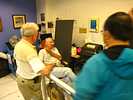
Ah, yes, I do have some of that new magnetic powder we used. Check with Grant Saviers about the details - 
but the can is almost empty, you can have a few grams to test - 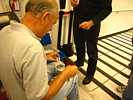
Allen visiting the RAMAC area 
Comparing the RAMAC and 729 clutches 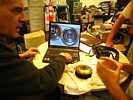
This drawing is on line here page 52. 
I have no idea what is going on - would you like to guess? Bob said "there are 15 turns here, more than the book says" - 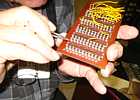
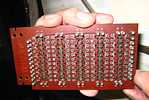
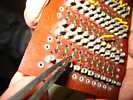
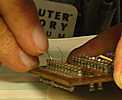
Ron Williams is showing the timing of a "Permissive Make" set of wire contacts in the IBM 1402 Reader/Punch - maybe twenty of these relays. 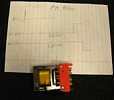
- A variable group of about 5 people spent all day talking about vacuum tubes and their circuits and failure mechanisms. Then the talk drifted to Williams Tube memories and how they did/did't work. Bob Erickson gave Bill Newman a diagram similar to those in Bob's IBM706-WilliamsTubeMemory which Bob had helped maintain at Los Alamos. There seems a pent up demand to reproduce some form of Williams Tube Memory
Dreaming on, maybe we could make a logical look-alike to the Manchester "Baby", the world's first working stored program fully electronic computer in the modern sense (gotta include a lot of weasel words in a claim like that ;-)) - but with a real CRT as the memory element -
